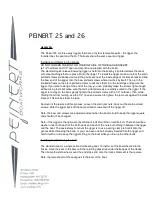
Always slow down and exercise extreme caution any time you are boating in area where there are people in
the water.
8.
Respect for environment
Please be aware of local environment laws and international regulations against marine pollution and respect
them as much as possible.
9.
Control Speed
Do not drive at top speed in areas of heavy boat traffic or in situations of reduced visibility, strong winds or
heavy seas. Reduce the boat’s speed in big waves and wake out of courtesy and for your own safety and the
safety of others. Observe speed limits and “NO WASH” signs.
10.
Others:
Do not sit in the bow cockpit when the boat is moving at high speed.
Danger
When operating, passengers must avoid standing up or hanging appendage outside of the boat. Leaking fuel is a
fire hazard, inspect fuel system regularly. Shut off the engine before boarding from the water.
Warning
Shall the operator or passenger fall out of the boat, the possibility of serious injury or death from being run over
by the boat can be greatly reduced by stopping the engine immediately. Always properly connect both ends of
the stop switch lanyard to the stop switch and the operator.
Caution
Passengers must use suitable PFDs. Special PFDs are designed for children or watersport activities. (Personal
Flotation Device)
Pre-operation check list
a)
. Make sure you every passenger is wearing a suitable personal flotation device.
b)
. Make sure there is an extra buoyant device that can be thrown to rescue person in the water.
c
.) If boating with passengers, instruct at least on passenger in the basics of boat handling, staring and operation
of the outboard motor.
d)
. Check that every passenger is securely seated and hold a safe line, grab handle or rope.
e)
. Make sure that there is a 4m towing rope in the boat.
f)
. Make sure the load in the boat is distributed evenly.
g)
. Make sure you respect the maximum load specified for the boat as described on the manufacturer’s plate.
h)
. Make sure that all safety gears is on board, e.g. whistle, floating ropes, waterproof flashlight, first aid kit, fresh
water, tool kit
…
i)
. Check that the boat is equipped with 2 paddlers or oars.
j)
. Make sure the outboard motor is securely fastened to the transom.
k)
. Make sure the drain plug is fully functional.
l)
. Check the pressure level in each chamber using a pressure gauge. Recommended working pressure is
displayed on manufacturer’s plate.
m)
. Check fuel tank level and make sure it suits your plan.
n)
. Start the outboard motor and make sure it stops when the lanyard is disconnected from the switch.






































